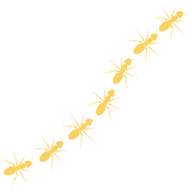Thief Ants
These ants are not afraid to take what is not theirs!
What do thief ants look like?
Worker thief ants are among the smallest ant species, measuring only 1.5-2mm, while the queens grow to around 4-5mm. Their colour ranges from yellowish tan to light brown, and they have a translucent appearance. Thief ants have two nodes connecting the thorax to the abdomen, with an unevenly shaped thorax. Thief ants closely resemble pharaoh ants and are often mistaken for them, telling them apart from each other takes a trained eye!

what is the difference between thief ants and pharaoh ants?
The primary distinguishing feature between thief ants and pharaoh ants is their antennae. Thief ants possess 10 segments with a 2-segmented club, whereas pharaoh ants have 12 segments and a 3-segmented club. The two species look strikingly similar, but they exhibit different behaviours.

Where do thief ants nest?
These ants are so small that they can easily access buildings through the tiniest cracks or openings. Their ability to nest in hard-to-reach places makes them highly adaptable, and they aren't particularly selective about where they set up home. Outdoors, they typically nest under objects that offer protection, such as rocks, fallen logs, or concrete slabs, and can often be found around the foundations of buildings. Indoors, they tend to nest near food sources, taking advantage of any small crack or crevice. Common nesting sites include wall voids, spaces under floors, and behind baseboards.
Thief ants are not averse to living in close proximity to other ant colonies - in fact, they prefer it. They intentionally build their nests near other ant colonies, and then create tiny intricate tunnels to sneak into the neighbouring nests.
What do they eat?
Thief ants primarily prefer high-protein and greasy foods, but they also have a taste for sweet, sugary treats. Their diet includes meat, cheese, grease, dead insects, dead animals, and even potato chips! Known for their relentless foraging, they will travel long distances to find food, leaving behind chemical trails for other colony members to follow. The sight of a trail leading from their food source is often a clear sign of an infestation. Their small size gives them a significant advantage, allowing them to sneak into packaged foods and forage throughout buildings without being noticed. But their opportunistic behaviour doesn’t stop at kitchens - thief ants also raid other colonies. They infiltrate nearby nests to steal food and brood, depleting the resources of the other colony and eventually taking it over. This strategy works in their favour, as it provides them with a steady food supply while minimizing their need to travel or expend energy.
Thief Ant colonies
Thief ant colonies have multiple queens, but their populations typically remain small. While they can have hundreds or even thousands of workers, the size of the colony depends largely on the availability of food. When a reliable food source is nearby, the colony doesn't need many workers, as foraging demands are minimal. However, if food is scarce, the colony's population grows to increase foraging efforts. New colonies are formed after the nuptial flight, which takes place in late summer to early fall. During this flight, it's been observed that some female queens are accompanied by several workers, who assist in helping the new queen establish her colony.
Worker ants attached onto the queen
The queen will remove her wings once she establishes her nest

What are the risks of having thief ants?
risk of food contamination
Thief ants pose a significant contamination risk to human food. They travel long distances to locate food sources, often venturing into unsanitary environments. These ants may forage on dead or decaying animals before making their way into your kitchen, potentially transferring harmful pathogens to your food. Their small size allows them to access both uncovered and packaged items, increasing the risk of contamination.
take note!

Thief ants foraging on a deceased bird.
Thief ants are often first noticed inside a home when they form trails leading to food. Due to their tiny size and ability to nest in small, hidden spaces, they can go undetected for a long time. If you spot ants lining up to a food source in your kitchen, don’t ignore it - this is one of the clearest signs of an infestation that needs to be addressed by a pest control professional!

How to get rid of thief ants?
If you have noticed thief ant activity inside or around your home, it is time to call in the pest control experts! Rural Routes Pest Control can provide control for the ant activity you are experiencing.
for more information about our ant control services.
